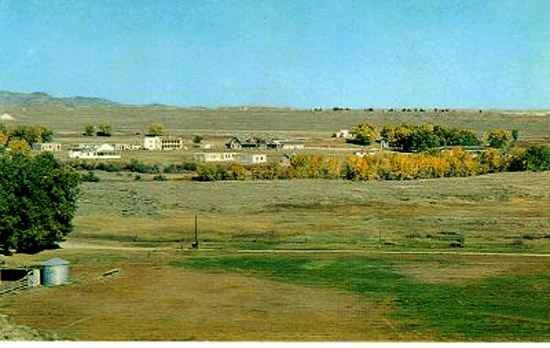
General View of Fort Laramie.
As depicted on the Previous Page
Ft. Laramie has in its history four incarnations: (A) a cottonwood stockade constructed at Laramie's
Point by the fur trading company of Sublette and Campbell named by Wm. Sublette
"Fort William", 1837; (B) an adobe fort, named "Fort John" but usually referred to as "Fort Laramie."
Some question exists as to the identity of Laramie from whom the location derived its name. As discussed on later pages,
it is possible that the location took its
name from a West Point graduate, Louis Lorimier, who entered, like his father before him, the
fur trading business and was killed by Indians along the Laramie River.
[Writer's note: Although there was a family in St. Louis named Aubry dit
Laramie, originally from Quebec, no connection between the Aubry family and the fur trade has been found. Thus,
it appears more likely that the name Laramie comes from the former second lieutenant. "Dit" denotes an adopted
name which was not a part of the patronomic name borne by a family. It was used to distinquish from other
families bearing the same surname. Dit, pronounced "dee," is close in meaning to the obsolete English
word "yclept."]
(C) a military post;
(D)
Finally, as depicted above, its present configuration consisting of a mix of restoration to the fort's 1880's appearance and ruins.
As later sidcussed, in 1825, William Ashley of Missouri commenced the practice of holding rendezvous for the purpose of trading goods for
furs. John Jacob Astor's American Fur Company maintained trading posts along the upper Missouri for the
same purpose. One of those trading posts or forts was Fort Union at the confluence of the
Yellowstone and the Upper Missouri. An upstart trading company Campbell and Sublette, owned by two mountain men William
Sublette and Robert Campbell, determined to beat the American Fur Company at its own game and constructed a rival fort a mere
two and a half miles from Fort Union. At the same time, there came a decline in demand for beaver pelts as a result of
a change of fashions in the Court of the French king, Louis-Philippe. His Majesty had appeared with a
silk top hat rather than with a beaver hat as was the style of the day. Beaver, as do wolves and
sled dogs, have a soft almost silky underfur from which the hats of the day would be made. Thus, the demand for beaver pelt was for the
underfur, not the coarser outer fur. As a result of the decline in the demand for beaver, stricter enforcement of laws relating to
sale of alcohol to Indians, and competition, John Jacob Astor and William Sublette entered into an agreement by which
Sublette and Campbell withdrew from the upper Missouri and Astor's American Fur Company withdrew from
east of the Rockies and South of the three forks of the Missouri.
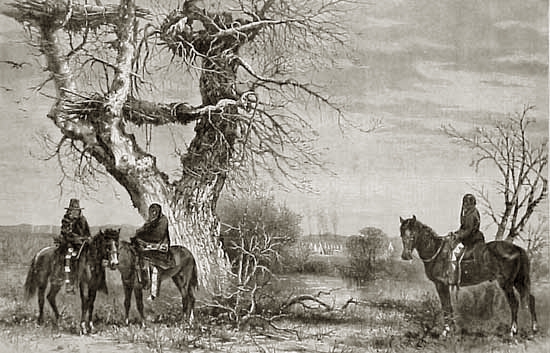
Indian Funerary Platform at Deer Creek, near Fort Laramie, woodcut, Harper's Weekly, 1869, based on photo by
Alexander Gardner.
The fort served as a
terminus of the "Trappers' Trail running from Taos northward.
The Trappers' Trail fell into disusage when fashions changed and silk replaced beaver in hats. The fading of
the Trappers' Trail proved the wisdom of Sublette and Campbell. The fort was also a
terminus for the 300 mile-long Fort Pierre-Fort Laramie Trail. Government freighters
continued to use the trail to Fort Pierre until the 1880's.
In due course, a license was obtained from the Indian Superintendent William Clark to construct a trading post at the
confluence of the Laramie River and the North Platt. In May 1834, William Sublette headed west and at Laramie Point the little fort
took shape. Inside were barracks, a storehouse, blacksmith's quaters and a horse corral. One of the Company, William Anderson, proposed to called the fort
"Fort Sublette." Sublette proposed "Fort Anderson." A compromise was reached honoring both, "Fort William."
In short order, however, Sublette and Campbell realized that the fort would probably be a money-loser.
Ceran St. Vrain and the Bent Brothers had already annouced plans to construct a rival fort. In early
1835, the fort was sold Fitzpatrick and Fontenelle, associated with the American Fur Company.
The artist Miller provided a
description of the fort as being:
of a quadrangular form, with block houses at diagonal corners
to sweep the fronts
in case of attack. Over the front entrance is a large blockhouse
in which is placed a cannon. The interior of the fort is about
150 feet square, surrounded by small cabins whose roofs reach
within 3 feet of the top of the palisades against which they abut.
The Indians encamp in great numbers here 3 or 4 times a year,
bringing peltries to be exchanged for dry goods, tobacco, beads
and alcohol. The Indians have a mortal horror of the "big gun"
which rests in the blockhouse, as they have had experience of
its prowess and witnessed the havoc produced by its loud "talk".
They conceive it to be only asleep and have a wholesome dread of
its being waked up.
A mile or so to the west of the Fort was another rival trading post known as Fort Platte.
Ft. Platte operated, however, for only about
five years before it was abandoned.
Fort Platte
was established in 1840-1841 by Lancaster Platt Lupton (1807-1885). It subsequently passed through the
hands of Sybille and Adams and Bernard Pratte and John Cabanne before it was abandoned in 1845.
Lupton also established trading posts near Chadron, Nebraska, and at Fort Lupton, Colorado.
Rufus B. Sage in his 1846 Rocky Mountain Life described the fort:
Fort Platte, being next to Fort Hall, the most important point on the route to Oregon, calls for
a brief description. This post occupies the left bank of the North Fork of Platte river, three-fourths of a mile
above the mouth of Laramie, in lat. 42o 20' 13" west from Greenwich and stands upon the
direct waggon road to Oregon via South Pass.
It is situated in the immediate vicinity of the Oglallia and Brule divisions of the Sioux nation, and but little remote
from the Cheyennes and Arapaho tribes. Its structure is a fair specimen of most of the establishments
employed in the Indian trade. Its walls are "adobies," (sun-baked brick,) four feet thick, by
twenty high -- enclosing an area of two hundred and fifty feet in lenght, by two hundred broad. At the
northwest and southwest corners are bastions which command its approaches in all
directions.
Within the walls are some twelve buildings in all, consisting as follows:
Office, store, warehouse, meat-house, smith's shop, carpenter's shop, kitchen, and
five dwellings, -- so arranged as to form a yard and corel, sufficiently large for
the accommodation and security of more than two hundred head of animals. the number of
men usually employed about the establishment is some thirty, whose chief duty it is to promote the
interests of the trade, and otherwise act as circumstances require.
The Fort is located in a level plain, fertile and interesting, bounded upon all sides by
hills, many of which present to view the nodding forms of pines and
cedars, that bescatter their surface, -- while the river bottoms, at various
points, are thickly studded with proud growths of cottonwood, ash, willow, and
box-elder, thus affordings its needful supplies of timber and fuel.
The alcohol, noted by Miller, was brought up the
Trappers Trail from Taos and sold for $4.00 a pint. Sage described the effect of the alcohol on the Indians:
Soon, individuals were noticed passing from one to another, with mouths
full of the coveted fire-water, drawing the lips of favored friends
in close contact, as if to kiss, and ejecting the contents of their
own into the eager mouths of others, -- thus affording the delighted
recipients tests of their fervent esteem in the heat and strength of the
strange draught.
At this stage of the game the American fur Company [Ft. Laramie], as is
charged, commenced dealing out to them, gratutiously, strong drugged
liquor, for the double purpose of preventing a sale of the article by its
competitor [Ft. Platte] in in [sic] trade, and of creating sickness,
or inciting contention among the Indians, while under the influence of
sudden intoxication, -- hoping thereby to induce the latter to charge its
ill effects upon an opposite source, and thus, by destroying the
credit of its rival, monoplize for itself the whole trade.
It is hard to predict, with certainty, what whould have been the result of
this reckless policy, had it been continued through the day. Already its
effects became apparent, and small knots of drunken Indians were seen
in various directions, quarrelling, preparing to fight, or fighting, -- while
others lay stretched upon the ground in helpless impotency, or staggered from
place to place with all the revolting attendencies of intoxication.
The drama, however, was here brought to a temporary close by an
incident which made a strange contrast in its immediate results.
One of the head chiefs of the Brule village, in riding at full speed from
Fort John to Fort Platte, being a little too drunk to navigate,
plunged headlong from his horse and broke his neck when within a few rods of
his destination. There was a touching display of confusion and excitement.
Men and sqaws commenced bawling like children; -- the whites were bad, very bad,
said they, in their grief, to give Susu-ciecha the fire-water that caused
his death. But the height of their censure was directed against
the American Fur Commpany, as its liquor had done the deed.
The whites were hardly better at holding their liquor. Sage described the effects on his
Company:
The night of our arrival at Fort Platte was the signal for a grand
jollification to all hands, (with two or three exceptions,) who soon got most
gloriously drunk, and such an illustration of the beauties of harmony as was
then perpetrated, would have rivalled Bedlam itself, or even the famous council chamber
beyond the Styx.
Yelling, screeching, firing, shouting, fighting, swearing, drinking, and
such like interesting performances, were kept up without intermission, --
and woe to the poor fellow who looked for repose that night, -- he might as well
have though of sleeping with a thousand cannon bellowing at his ears.
The scene was prolonged till near sundown the next day, and several made their egress from
this beastly carousal, minus shirts and coats, -- with swollen eyes, bloody noses, and
empty pockets, -- the latter circumstances will be easily understood upon the mere mention of
the fact, that liquor, in this country, is sold for four dollars per pint.
In 1841, the stockade was replaced by an adobe structure. While generally
referred to by fort employees as "Fort Laramie," it was named Fort John, after
John Sarpy, a partner in the American Fur Company.
The fort maintained its importance on the Oregon Trail and Mormon Trail and subsequently during the
Indian Wars.
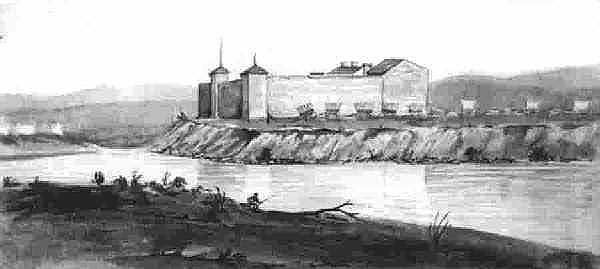
Ft. Laramie, 1849, sketch by James Wilkins
The adobe construction of Fort Laramie was described by Francis Parkman, "The Oregon Trail," serialized in
Knickerbocker's Magazine in 21 installments, 1847-48, later published with revisions as
"The California and Oregon Trail,":
"The little fort is built
of bricks dried in the sun, and externally is of an oblong form, with
bastions of clay, in the form of ordinary blockhouses, at two of the
corners. The walls are about fifteen feet high, and surmounted by a slender
palisade. The roofs of the apartments within, which are built close against
the walls, serve the purpose of a banquette. Within, the fort is divided by
a partition; on one side is the square area surrounded by the storerooms,
offices, and apartments of the inmates; on the other is the corral,
a narrow place, encompassed by the high clay walls, where at night, or in
presence of dangerous Indians, the horses and mules of the fort are crowded
for safe-keeping. The main entrance has two gates, with an arched passage
intervening. A little square window, quite high above the ground, opens
laterally from an adjoining chamber into this passage; so that when the
inner gate is closed and barred, a person without may still hold
communication with those within through this narrow aperture. This obviates
the necessity of admitting suspicious Indians, for purposes of trading,
into the body of the fort; for when danger is apprehended, the inner gate
is shut fast, and all traffic is carried on by means of the little window.
This precaution, though highly necessary at some of the company's posts, is
now seldom resorted to at Fort Laramie; where, though men are frequently
killed in its neighborhood, no apprehensions are now entertained of any
general designs of hostility from the Indians."
In 1849, the military purchased the fort for the sum of $4,000. The first units arrived on
July 16, 1949.
One of the first structures construced was a pre-fabricated building now known as "Old Bedlam" brought in
pieces from Fort Leavenworth allegedly at a total cost of $40,000.
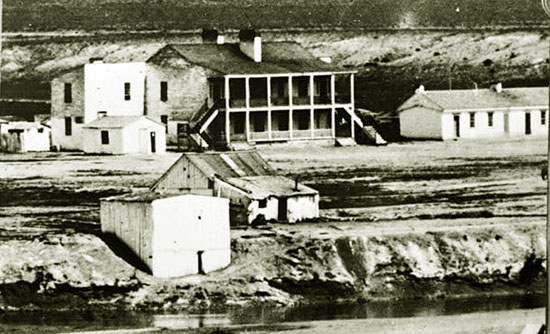
"Old Bedlam" undated.
Old Bedlam apparently took its name from the antics of young officers when the structure was used
as Bachelor Officers' Quarters.
One officer, James Regan, "Military Landmarks" ,
Unites Service, Vol. 3, 1880 p. 148 et seq
wrote of Old Bedlam, "The episodes connected with this old building, were they well
known and properly told, would form a volume in themselves.
We have ourselves seen every room from lower to upper story brilliantly lighted and
filled with card-parties, composed of officers, some of whom have since become distinguished."
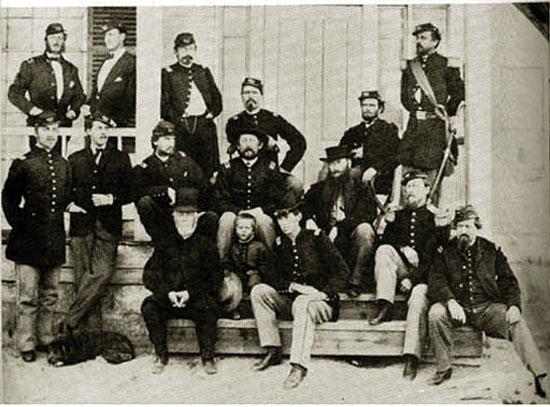
Officers on steps of "Old Bedlam," 1860's.
It has been contended that the above photo was taken in 1864 and shows the only known adult image of Caspar W. Collins after whom
Ft. Caspar and Casper, Wyoming were named. See D. P. Robrock, The Eleventh Ohio Volunteer Cavalry on the Central Plains, 1862-1866.
The National Park Service has dated the photo as 1864 which would have been consistent with the Eleventh Ohio. It has also been contended that the photo is from
the 1868 Ft. Laramie Treaty negotiations and shows infantry officers. See John Dishon McDermott, Circle of Fire, The Indian War of 1865, Stackpole Books,
2003. McDermott writes:
"For many years, historians believed that US Signal Corps Photo 102953 included Collins.
However, careful examination of the officers' insignia showed the men to be members of the
4th US Infantry." p. 199
Allegedly, in the front row on the left is Capt Levi Monroe Rinehart. Next to him, with the dog at his feet, is Lt. Caspar W. Collins.
Capt. Rinehart, Company G, 11th Ohio Volunteers, was killed in a skirmish with Cheyenne Indians on the
North Platte near Deer creek on February 13, 1865. He had previously served in the Union Army, was captured by
Confederate forces near Harper's Ferry, but was exchanged. Lt. Collins was the son of the
commander of Fort Laramie, Lt. Colonel William O. Collins. Lt. Collins was kiled on July 26, 1865 at the
Battle of the Platte River Bridge.
Officers' insignia were worn on the front of the forage caps worn by most of the men in the
photograph. Cavalry insignia would have been a pair of crossed sabers, whilst infantry would at the time have been an
infantry horn. The Cavalry insignia would have been symmetric The bell side of the horn would have provided a slightly asymetric image with the larger side on the
viewer's left. Although even enlarging the photo and sharpening the image still provides an indistinct image of the insignia, the
asymmetry, however, leads the writer to the belief that more likely than not, the officers are infantry.
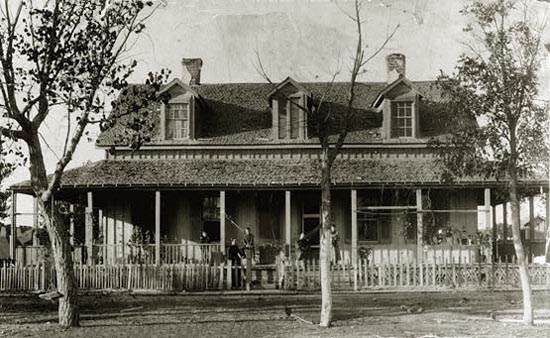
Officers Quarters, undated.
The above building is still in existence. It was orginally constructed as the
quarters for the commanding officers, but was converted into a duplex. When the
fort was abandoned, the building was sold to Meade Sandercock who occupied it until 1916. Thereafter it was rented out and
finally abandoned. See photos next page. The commanding officer's quarters was divided into a
duplex and the commanding officer used another structure depicted on the next page as his
quarters. The building depicted has now been restored and sits partially on the site of the
original Fort William.
Ft. Laramie Photos continued on next page.
|